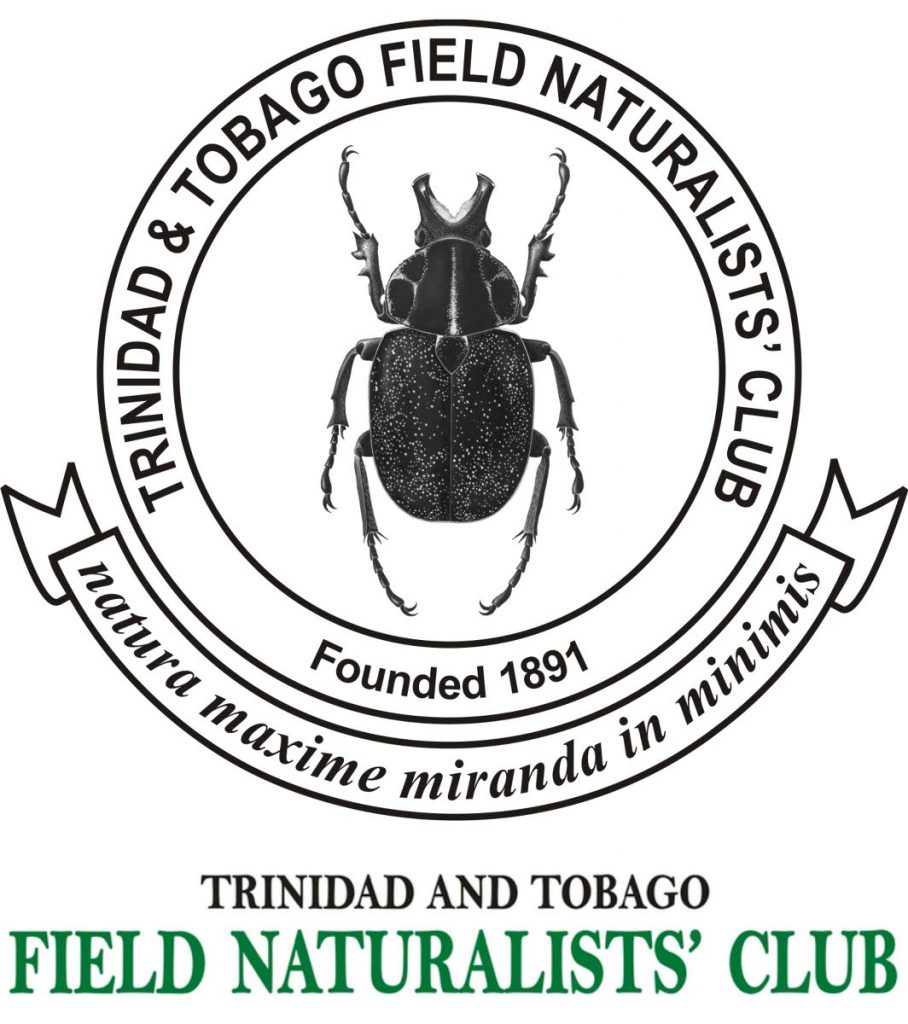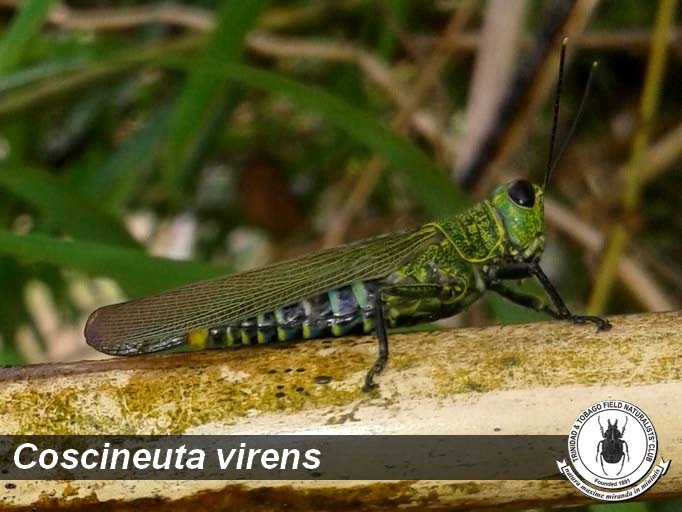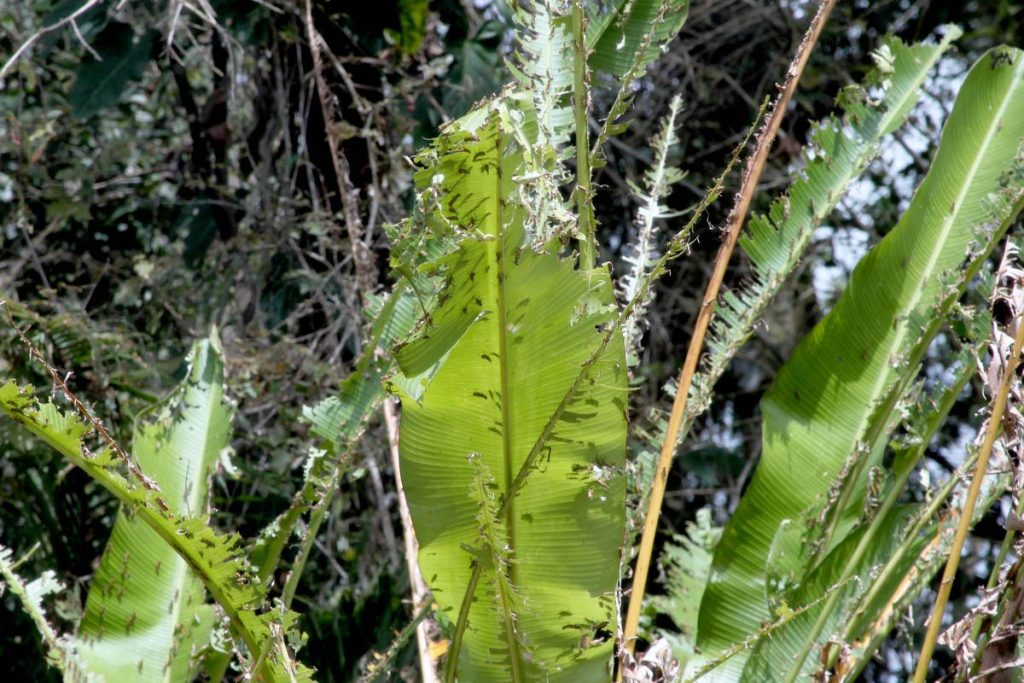The Moruga Grasshopper

Jo-Anne Nina Sewlal
The Coscineuta virens commonly called the Moruga Grasshopper or locust, have made a regular appearance in the national news due to the damage caused by their feeding activities when they swarm. Swarms are regularly reported from areas such as Chatam and Rio Claro. But what is a locust? Locusts do not refer to a species of insect but rather to the migratory phase of some grasshopper species, during which time they form swarms.
Moruga Grasshoppers have probably inhabited our forests long before the first people came to our shores. In all that time, it was never truly considered a “pest” until the early 1900s. They were usually confined to the forest reserves in south Trinidad, sighted mainly by those who ventured into the deep recesses of the forest. This is to be expected since this species usually resides high up in the forest canopy, some 40 to 50 metres above the forest floor. While not limited to Moruga, the common name possibly resulted from the species being more visible in the Moruga district where swarms developed in association with the area’s naturally occurring stands of mora trees.

However, the spread of this species was predicted about three decades ago as more and more of forested areas were cleared for timber, agriculture, urban and industrial use.
These tiny insects also do not discriminate when it comes to the plants they consume as they feed on approximately 78 species which include food crops, ornamentals, shade plants, medicinal plants, weeds and those of religious and cultural significance. Although this species feeds mainly on leaves it may occasionally cause damage to shoots, buds and flowers. Their ability to consume a wide range of plants means that as more and more land was cleared due to human activities, this former forest species was now considered a pest species, reflecting the grasshopper’s ability to adapt to a changing environment. Its feeding activities are also erratic with the different life stages feeding on different plants and different parts of a plant. For instance, a plant species eaten in one year may be untouched the next.
The introduction of monocultures (cultivations of a single plant species) for cocoa, coffee, teak and other agricultural crops, as well as the introduction of exotic species is believed to have aided the spread of these grasshoppers from their forest homes via these modern agricultural systems. Outside of the natural mora climax forests of south west Trinidad, in the past the grasshoppers would have had to survive in a world of mixed vegetation types which limited their survival success. Now, thanks to man, they could access vast areas with dense plantings of high quality food plants.

The negative impact of the grasshopper swarms, which tend to emerge in the dry season, can also amplify the already harsh growing conditions that some crops are faced with. Some crops may not be watered during the dry season so that the plants are already water-stressed. If a swarm of grasshoppers then consumes a significant amount of the plant’s leaves, this further impairs the plant’s functions and the quality of produce deteriorates.
The annual emergence of large swarms of grasshoppers may even impact ecosystems via a loss of biodiversity and general instability. The rapid loss in vegetation cover could result in increased run-off of rainfall which may result in flooding and water pollution as pesticides from attempts to eradicate the swarms are washed into rivers and streams. But at the same time these insects can be quite beneficial to the environment. Grazing by grasshoppers is reported to actually stimulate plant growth. They also play a part in nutrient cycling and in food chains by adding faecal matter to the soil and plant material that they have chewed off, which falls to the ground and decays. Also, when they die, their decaying bodies provide the soil with valuable nutrients. The grasshoppers themselves are preyed upon by several other animals including insect eating birds, like the Plumbeous Kite, which will follow the swarms for an easy feast.
Knowledge of their life cycle is key to controlling their population, especially recognizing their egg beds, since they lay their eggs in the soil. Also, by recognising their resting sites of the juveniles (otherwise known as “hoppers” because their wings have not matured so they hop to get around) the swarms can be more effectively targeted by mist blowers. Care, of course, has to be taken with respect to the pesticides used since general pesticides kill more than the targeted species and not only affect our biodiversity but can also leave harmful residues on plants such as food crops.
In living with these locusts, we should aim to control and not eradicate them. Remember this was once a species only encountered deep in our forests, turned into a pest species by our own activities. They have a rightful place in our country’s ecosystem.
For more information on our natural environment, contact the TT Field Naturalists’ Club at admin@ttfnc.org or visit our website at www.ttfnc.org and our Facebook or YouTube pages
.


Comments
"The Moruga Grasshopper"